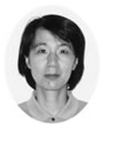|
Affiliation |
Doctorial Course in Health Sciences Nursing Course |
HASEBE Makiko
|
|
|
Research Interests 【 display / non-display 】
-
Nursing education Labor safety hygiene
Graduating School 【 display / non-display 】
-
-2000
Akita University Graduate School of Education Graduate School of Education Graduated
-
1979.04-1983.03
Akita University Graduated
-
-1983
Akita University Faculty of Mining Graduated
-
-1983
Akita University Faculty of Mining Graduated
Graduate School 【 display / non-display 】
-
1998.04-2000.03
Akita University Graduate School, Division of Education Master's Course Completed
Campus Career 【 display / non-display 】
-
2020.04-Now
Akita University Doctorial Course in Health Sciences Nursing Course Associate Professor
-
2009.04-2020.03
Akita University Graduate School of Medicine Doctorial Course in Health Sciences Basic Nursing Associate Professor
Research Areas 【 display / non-display 】
-
Life Science / Fundamental of nursing
-
Life Science / Fundamental of nursing
Research Achievements 【 display / non-display 】
-
Actual Situation and Management of Allergies among Nurses Working in Hospitals in Japan
Sasaki Makiko, Kikuchi Yukiko, Kudo Yukiko, Hasebe Makiko, Sugiyama Reiko
Journal of Japan Society of Nursing Research ( Japan Society of Nursing Research ) 46 ( 4 ) 4_693 - 4_702 2023.10
<p>Objective: This study aims to clarify the actual situation and management of allergies among nurses working in hospitals in Japan. Methods: We conducted a cross-sectional survey using a self-administered questionnaire. The question items included the presence or absence and onset of allergies, frequency of contact with allergens, and tissue health care. Results: A total of 264 valid responses were analyzed. The results indicated that 82.6% of the respondents had at least one allergic symptom. The most common allergy was allergic rhinitis (41.7%). In all cases, the onset time for those with allergies to rubber products was after admission to a primary nursing educational institution or employment. Moreover, 32.2% of the respondents indicated that their allergic symptoms worsened after entering nursing. Significant associations existed between increased allergic symptoms after employment and allergies to rubber products, detergents, or soap and allergic rhinitis. The results also revealed assigning the management of allergies to individual nurses. Conclusions: This study revealed that allergy management in the workplace was poor, even though most of the nurses had allergic symptoms. Therefore, in addition to a deeper understanding of allergies among nurses, improved allergy management in the workplace is needed.</p>
-
Kikuchi Yukiko, Sasaki Makiko, Hasebe Makiko, Kudo Yukiko, Sugiyama Reiko, Muto Ryosuke, Ishii Noriko
SANGYO EISEIGAKU ZASSHI ( Japan Society for Occupational Health ) advpub ( 0 ) 82 - 90 2022
<p><b>Objective:</b> Individuals in nursing occupations are often exposed to various materials such as rubber products and drugs, and they comprise a population at high risk of developing occupational allergies. We therefore created a "Health management guideline on occupational allergy in nursing occupations and its primary prevention" (hereinafter referred to as "HMG") and conducted a questionnaire survey to elucidate its potential use and the challenges of implementing it in clinical practice. <b>Subjects and Methods: </b>The HMG includes the following content: A. Basic knowledge of occupational allergies; B. Common occupational allergies in nursing occupations; C. Occupational allergies triggered by specific antigens in nursing occupations; D. Eczema and skincare for hands; and E. Health management for occupational allergies. A questionnaire survey was conducted on one nursing manager each from 80 hospitals, with at least 400 beds. The survey included questions to gauge the level of understanding the content described in the HMG and opinions on incorporating the management method. The ethics committee of the researcher's institution approved the study. <b>Results:</b> Responses were obtained from 30 nursing managers. Over 70% responded that they understood the instructions for [occupational allergies], [common occupational allergies in nursing occupations], and [eczema and skincare for hands] presented in the HMG, and 100% said they either understood or mostly understood them. For [work management], 57% said they understood the content and 90% wanted to incorporate it. Furthermore, 10% responded that they wanted to incorporate the guidelines but did not believe it was feasible, given that "achieving general awareness and efforts involving other occupations are difficult." For [work environment management], 53% said they understood the content and 83% wanted to incorporate it. Additionally, 17% responded that they wanted to incorporate it but did not believe it was feasible, amid concerns that "allergen monitoring is difficult in reality" and "installation of local ventilation systems seems difficult." <b>Discussion and Conclusions:</b> The HMG was postulated to be useful in providing knowledge on occupational allergy and health management methods, and for employing in clinical practice. The study recommended that in order to specifically incorporate the management methods, it is imperative that the entire hospital, including staff from other occupations, understand the guidelines and make adjustments accordingly.</p>

